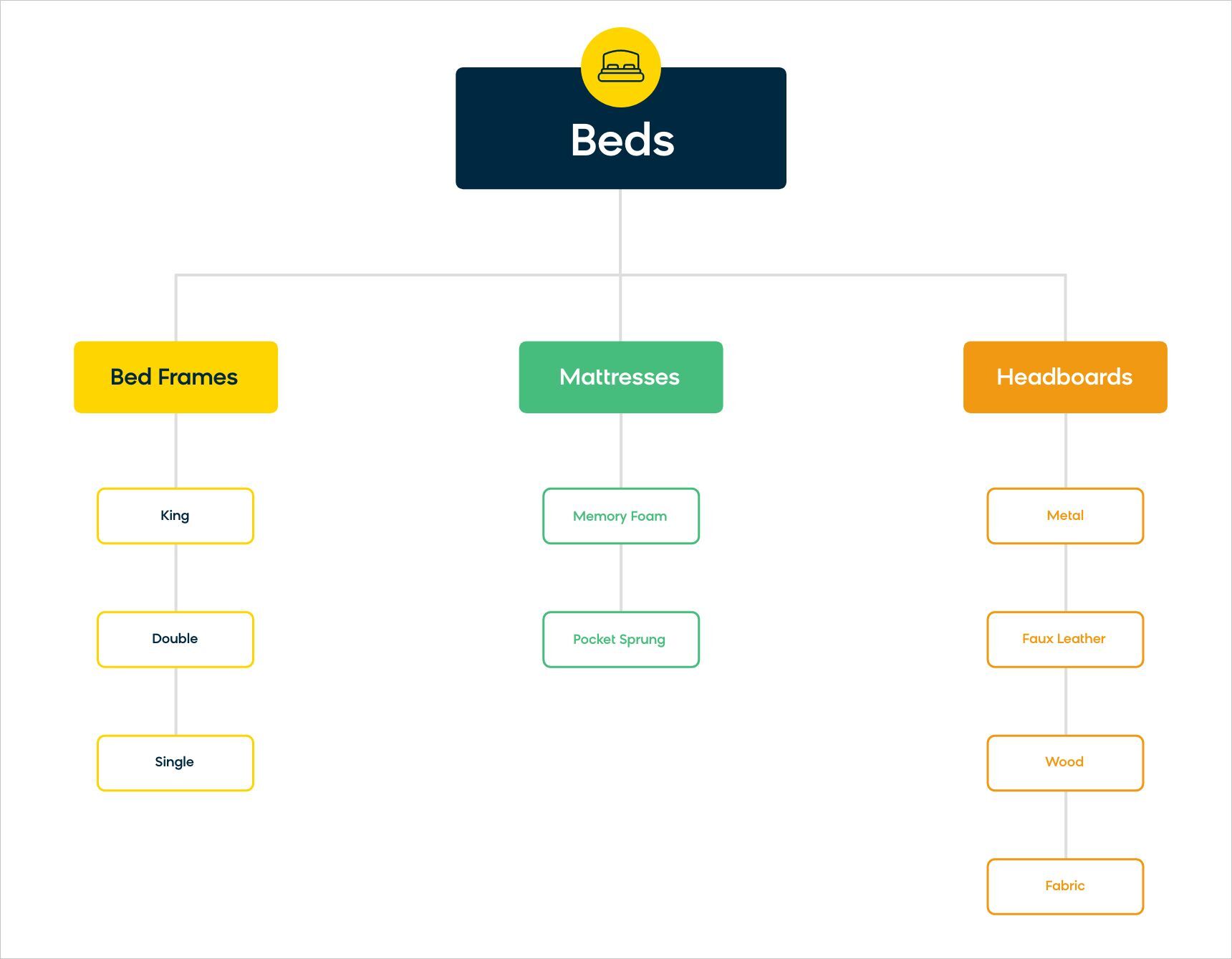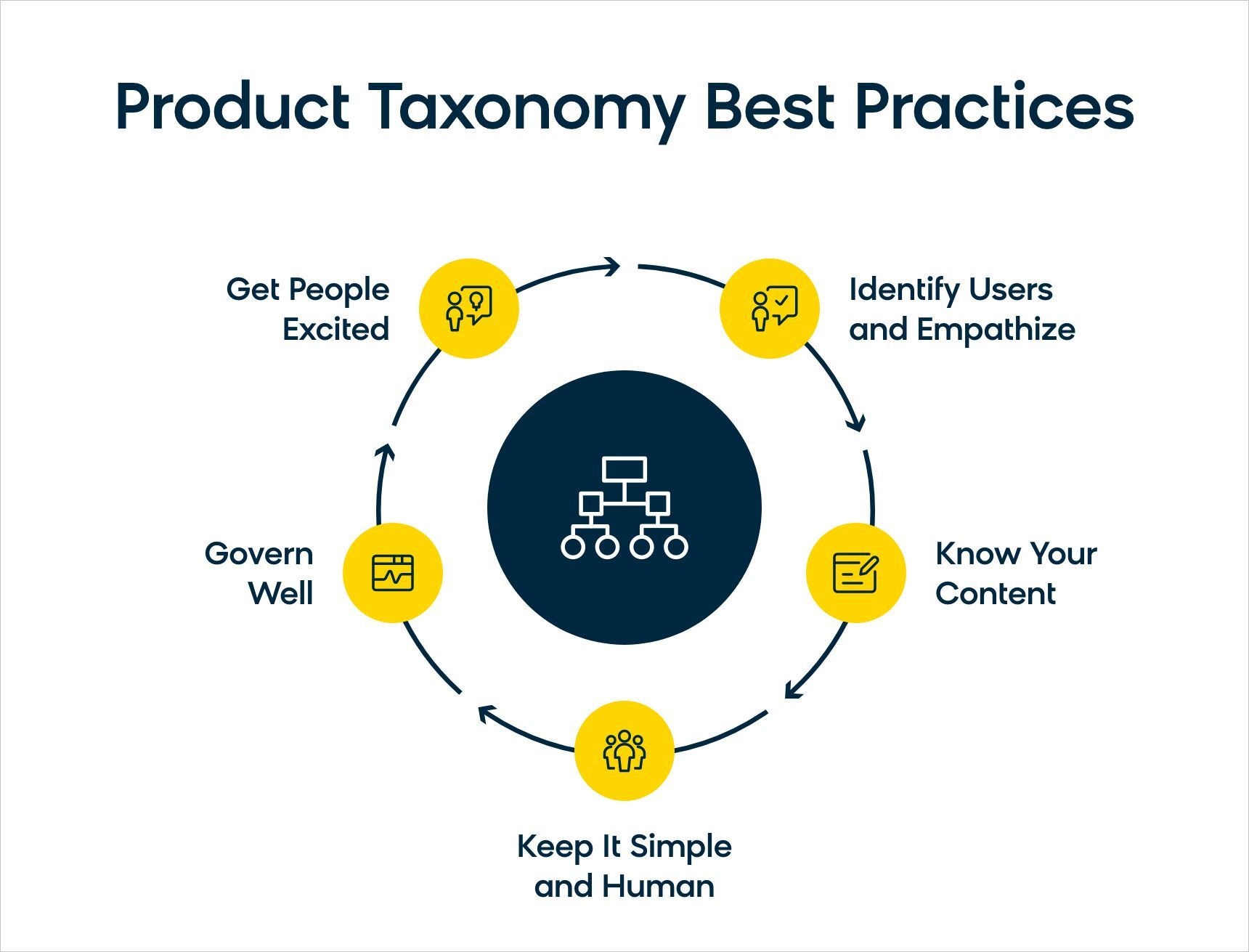Product Taxonomy: Your Route to Increased Traffic and Sales
By Tessa Roberts
01/25/2023

Taxonomy — it’s got nothing to do with paying your taxes, but it does have a lot to do with your bottom line.
Any company looking to sell products online (especially if you have multiple products) needs to give them the correct names and put them in the correct categories. Otherwise, customers — both current and new — simply can’t find them.
That’s where product taxonomy comes into play. Learn more about product taxonomy and why it’s important, as well as how a proper taxonomy structure can boost revenue.
What Is Product Taxonomy?
Product taxonomy is a structure to organize everything in your product catalog in a logical way so that customers can find what they want in the fewest clicks possible.
Generally, they work as a product hierarchy that puts products into categories, and tags are used to group products into each category. Additional product data, such as attributes (e.g., color or size) are then applied to the items in each product category.
Here’s an example of a basic product taxonomy structure:

The end result is that customers can move easily through all levels to find exactly what they want.
Multiple independent taxonomies can also be overlaid for different views on the same data. For example, in a database of music, a product could be found via genre or record label.
When the right product shows up in a search, it’s much more likely that it’ll result in a purchase. Product taxonomy organizes everything in the background to make that happen.
Why Is Product Taxonomy Important?
If you optimize your ecommerce site with a well-organized product taxonomy, you’ll be able to provide a better shopping experience that your customers can intuitively navigate. It all comes down to customer behavior: Imagine a customer searching the “Fresh Food” category to find bread. They come up empty-handed, as that product is only found in the “Bakery” category.
With limited shopping time, the customer becomes frustrated and abandons the search — not an ideal result. When the proper category names aren’t in place, the results are reflected in lost sales. Over time, confidence in the brand will take a hit too.
Some of the benefits of product taxonomy include:
- Increased conversions
- More revenue
- Greater brand loyalty
- Improved SEO (and as a result, site traffic)
- Better internal organization and reporting
You might wonder why all of this can’t be handled via the search bar. The answer is: If your data and product catalog aren't well organized with a clear hierarchy in the first place, then search won’t work. It’s the classic “garbage in, garbage out” scenario — the quality of your output (your search results) is only as good as the quality of your input (your product taxonomies).
There’s no avoiding product taxonomy. It’s the groundwork retailers must focus on to prevent users from leaving their site before finding what they want.
How Product Taxonomy Can Boost Sales
It’s clear that without the right product classification in place, website visitors will rarely compensate by continuing to try and find the product(s) they want. They just give up.
Visitors to your site are generally searchers or browsers. With browsers, products must be in the right place, but you do get a little bit of extra time to deliver on the search terms.
Searchers, however, know exactly what they are looking for. They will be more specific and expect to find exactly what they want, alongside a list of alternative selections.
 Read this next: Everything You Need To Know About Ecommerce Search Bars [blog]
Read this next: Everything You Need To Know About Ecommerce Search Bars [blog]
A well-built taxonomy will allow your website to display related products. Rather than losing a sale if a product is not available, you get that conversion by offering something else.
Conversion rates aside, taxonomy also has a big impact on internal decision-making. Strong reporting and analytics are needed to know which products are selling and which are not.
As with any reporting system, good input is key. Distinct categories and correct labeling make it much easier to deliver accurate stats across a full product catalog. When it’s clear what each product is called and where it sits, reports are more reliable. Decisions on what products to feature or drop therefore become more data-driven and effective.
Do You Need a Taxonomist on Your Team?

Many companies recognize the importance of a good, clean taxonomy, but not all are in a position to do something about it. Some businesses put serious resources behind product taxonomy. They hire dedicated taxonomists, people with advanced degrees in library/information science or even linguistics.
That’s not possible for the average company, however. In many cases, taxonomy is just a side project — one that’s added to a long list of other tasks.
Assuming most companies won’t have such dedicated resources at their disposal, how can they properly address their taxonomy challenges?
The main thing to remember is that good taxonomies are not created to be a vacuum. They interact with the world a user lives in, being informed by how customers interact, as well as trends and even cultural differences. Some best practices are outlined below.
Product Taxonomy Best Practices
On the surface, it may not seem the most glamorous of endeavors, but building or improving your taxonomy directly leads to increased traffic and sales.
Getting it right means looking beyond logic and navigation. A good product taxonomy will also account for the human element.
Here are five best practices you can apply:

Get People Excited
It’s important to get the internal team on board. That way they will be more supportive. Part of that will be evangelizing the benefits of good naming and solid categorization.
After all, when people can find products quickly, they buy more and they’ll keep coming back. Loyal customers benefit everyone in the company. Explain why building or refining the taxonomy is an important process. Try to build an understanding that customers may use a different vocabulary to the one used in-house.
Illustrate these differences to bring it to life. For example, a shopper might be searching for a nightstand, but may not know to look for that term while browsing. Having a good organizational structure in place will make it easier for that potential customer to be guided to the right place and convert.
Identify Users and Empathize
Taxonomies should be built for users, so this practice comes with an element of (data-driven) psychology. You need to understand user behavior and the language they use.
To understand the type of taxonomy that suits your customers, you need to study them a little. See how they navigate your site. Analyze data on the customer experience to see how they think and how they might approach your site to find a product.
You can also just talk to people. Ask what they like and what they don’t like about the current setup. See if they can describe what their ideal system would look like.
If it’s not working, resist the urge to blame the user. They may not always type in the right terms, but it’s not their job to figure out your site. Remember: A good taxonomy is built for the user — not the other way around.
Read this next: A Single Customer View (SCV): Everything You Need To Know [blog]
Know Your Content
Get a deep understanding of the data you’re working with and how it’s structured. Ask yourself:
- Is it documented?
- Does it come from multiple sources?
- Where does it all sit?
Armed with the fuller picture, any efforts to organize things will be more effective. This will also help you estimate the project’s size and to prioritize.
For example, it could be the case that you don’t have enough content to support a particular category. If so, consider incorporating that at a later stage.
Sometimes things can wait while you focus on items that are more pertinent. When you know what content really matters, it will be easier to make those decisions.
Keep It Simple and Human
Building a product taxonomy can begin with something as simple as writing on cards. Write terms on cards and sort them. Visualize the product categories. Determine where products, with their various attributes, sit within them. And lay it all out.
A complicated taxonomy won’t work, so keep it simple. When it comes to options and the list of choices beneath them, go broad and shallow, rather than narrow and deep. Keep hierarchies to two or three categories. Yes, users want organization, but they don’t want an endless list of categories to trawl through.
Be consistent with names and remember the user at every stage. Use terms they can understand and employ synonyms to facilitate product search. Even for B2B customers, try to avoid a heavy use of industry jargon.
Although it can be tempting for products that don’t seem to fit anywhere, try to avoid the dreaded “Other” category. In reality, users rarely spend time looking there.
Read this next: 6 Ecommerce Case Studies To Inspire You [blog]
Govern Well
When you have built a taxonomy, you need to observe how people use it. Be prepared for people to interact with your taxonomy in ways you never imagined.
This work is never truly done — taxonomies constantly change, especially in retail. Regular reviews and modifications of the existing structure will be necessary as part of an ongoing effort.
It will all come down to what users are doing. New ideas will appear out of the blue and they will quickly become must-have terms. Adding product names, categories, and attributes never stops.
All the while, the taxonomy should be shared across business units. Customers don’t have, and don’t want, any visibility over the internal company structure. Make sure everyone speaks with the same voice.
How Product Taxonomy and Site Search Work Together
As important as product taxonomy is, you also can’t forget about site search. These two should go hand in hand to drive the biggest impact on your site. A well-organized product taxonomy makes it easy for browsers to find what they’re looking for — they can click around until they find the right category, and then view all the items within that section.
On the other hand, with the right site search tool, you can convert shoppers who have more of an idea of what they’re looking for. In particular, you’ll want a tool that can understand their intent and automatically prioritize certain products for you.
By both investing in product search and optimizing your product taxonomy, you’ll create a better customer experience that improves conversions and revenue — without being time-consuming. Let’s see how some companies have accomplished this.
How Companies Use Product Taxonomy and Site Search
Level Nine Sports
Level Nine Sports is a top snowboarding, skiing, biking, and outdoor retailer in the US. The company wanted to create an equally personalized shopping experience online as it could in its brick-and-mortar locations.
To do this, Level Nine Sports turned to Bloomreach Discovery for its product discovery solution. With Bloomreach’s AI, the brand could rest assured that it was delivering relevant results and avoiding null results. For example, if a customer searched for very specific terms like “backcountry avalanche transceiver,” the search would understand the customer’s intent and serve the right results.
Bloomreach could also help with the issue of inventory (especially niche items) staying in the warehouse for too long. A great product taxonomy helped customers find the categories they were looking for more easily, and then Bloomreach’s site merchandising tools helped the company boost items they wanted to sell off on the relevant category pages.
As a result of this implementation, Level Nine Sports saw big gains, including a 23.4% increase in conversion rate and a 42% increase in time spent on its website after search.
Read the full story: Level Nine Sports Increases Conversion Rate by 23% With Bloomreach Discovery and BigCommerce
HD Supply
HD Supply is a large industrial distributor in North America, which means it has to juggle a lot of different product categories. To help its buyers make purchases quickly and reliably, it knew it needed to revamp its site experience. That’s why HD Supply decided to use Bloomreach Discovery.
As part of its revamp, HD Supply added the ability to “add to cart” directly from the search bar. Buyers could now see the product image, part number, price, and the option to add the product to their cart. Bloomreach Discovery’s algorithm is hard at work in the background too, providing relevant search results and boosting certain products on specific category pages.
With these changes in place, HD Supply saw a 16% increase in revenue from search, as well as a 4% increase in add-to-cart rate, proving that the powerful combination of product taxonomy and site search can drive big results for a company’s bottom line.
Read the full story: HD Supply Increases Search Revenue With Bloomreach Discovery
Make Your Product Taxonomy Drive Results With Bloomreach
Great product categorization plays a critical role in how “browsable” your site is, but it’s not the whole story. With the right product discovery solution in place, like Bloomreach Discovery, you can make key updates that greatly enhance your customers’ shopping experience.
With the largest ecommerce dataset out there, extensive learnings and solutions across every industry, and smart merchandising tools, Bloomreach Discovery gives you a clear advantage over your competitors in a digital marketplace that’s seeing increasingly high customer expectations.
Ready to grow revenue on your site? Find out how you can drive faster ROI with the right product discovery solution.
Found this useful? Subscribe to our newsletter or share it.







